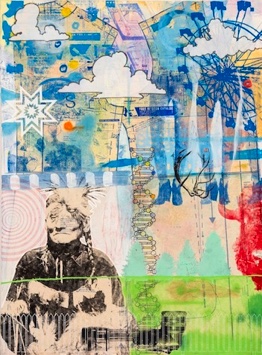Click the logo to go to the Lakota Emergence
homepage
The leader of the Pte people was Tatanka. It was probably he who suggested that Tokahe and the other three men go as scouts to this world. These four men met the wolf during the full moon and followed him into the cave’s entrance. They were the first Pte people to choose to leave the underworld. The four scouts, however apprehensive they might have been about leaving, must have figured they would return safely to their homes.
Micheal Two Bulls played off the ellipses at the end of the passage to both title his piece and to suggest a narrative direction different from the original, thereby inserting contemporary agency into the old emergence text. Micheal is a printmaker who uses “layers and layers and layers” of contemporary and traditional imagery to create artworks that tell many stories. He emphasizes the inevitability and perhaps even necessity of change, especially in Lakota storytelling traditions: “I imagine that each time a story is told, something is added or taken away; every time you tell a story it changes.”
In his complex piece, Micheal layers in images of family, fashion, firearms and fun. In the foreground is an image of Jimmy Comes Again, Micheal’s great-great grandfather who was one of the last survivors of the Little Bighorn battle, overlaid with an image of a Vietnam-era flashlight issued to “tunnel rats,” which is overlaid with a picket fence that Micheal says “doesn’t exist in America anymore.” Lakotas of Jimmy Comes Again’s generation experienced tremendous cultural changes brought about by forces beyond their imagination and control. In a sense, like their long ago Pte ancestors, they were born in one world but died in a different one.
A double helix strand of “DNA coming out of the ground” crosses a green line dividing the underworld from the upperworld, passing behind a line of pine trees, perhaps representative of the region of the pines where Wazi and Kanka taught the people from the underworld how to live on this earth.
The meanings of his work are cultural and personal and purposefully uncertain, “so it tells its tale, in its own sense.” Or as Micheal hints, it is “my own personal tale I guess.” They are layered with uncertainties and therefore have many “interpretations just like a story does,” he says. Rather than dictate literal meanings, Micheal invites viewers to create their own understandings of his work based on their personal experiences and histories.
Then an old man suggested that three men go with Tokahe to see these things, so that the people would know that Tokahe told the truth.
Tokahe chose three strong and brave young men and when the moon was round they met the wolf. It led them through the cave...

